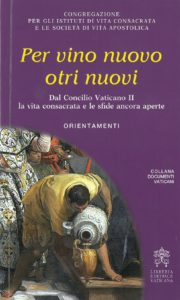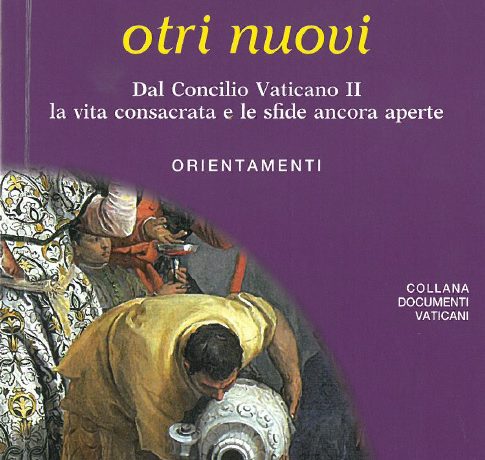 This new volume (Libreria Editrice Vaticana, 2017) contains the thoughts that emerged during the course of the plenary assembly of the Congregation for Institutes of Consecrated Life and Societies of Apostolic Life that was held on 27-30 November 2014 and whose subject was ‘New Wine in New Wineskins. Consecrated Life Fifty Years after Lumen gentium and Pefectae caritatis’. Attention was paid to the journey undertaken by consecrated life since the Second Vatican Council and an attempt was made to engage in a summarising reading of the challenges that still exist.
This new volume (Libreria Editrice Vaticana, 2017) contains the thoughts that emerged during the course of the plenary assembly of the Congregation for Institutes of Consecrated Life and Societies of Apostolic Life that was held on 27-30 November 2014 and whose subject was ‘New Wine in New Wineskins. Consecrated Life Fifty Years after Lumen gentium and Pefectae caritatis’. Attention was paid to the journey undertaken by consecrated life since the Second Vatican Council and an attempt was made to engage in a summarising reading of the challenges that still exist.
These ‘Orientations’ are also the outcome of what emerged following the numerous meetings which, during the course ‘of the Year of Consecrated Life witnessed converge on Rome, at the See of Peter, consecrated women and men from every part of the world’ (page 7).
The Magisterium of the Church, starting with the Second Vatican Council, has always accompanied the lives of consecrated people through major coordinates of reference and values as well. One may think of ‘the Instructions Potissimum institutioni (1990), Fraternal Life in Community (1994), Starting Afresh from Christ (2002), The Service of Authority and Obedience, Faciem tuam (2008), and Identity and Mission of the Religious Brother in the Church (2015)’.
The objective of these orientations is also to engage in a survey of the fifty years that separate us from the Second Vatican Council; a pause to discern the quality and the ageing of the new wine produced by the long season of renewal after that Council and to assess the conformity and the coherence of institutional forms that are present in consecrated life.
This document starts with a statement made by Christ: ‘No one sews a piece of unshrunk cloth on an old garment; if he does, the patch tears away from it, the new from the old, and a worse tear is made. And no one puts new wine into old wineskins; if he does, the wine will burst the skins, and the wine is lost, and so are the skins; but new wine is for fresh skins’ (Mk 2:21-22). With this phrase Jesus warns his disciples about the temptation of wanting to harmonise in one’s own life the freshness and vitality of the message of Jesus with an old mentality dominated by justice which is certainly not that of Jesus. He warns them against Pharisee-like tendencies which also arose in the early Christian community and ran the risk of denaturing the profound message of the Gospel which is based upon the law of freedom, on truth that truly makes people free. We are dealing here with dry and rigid wineskins, ancient structures that cannot contain the force of the new good wine, which is nothing else but the joyous and sparkling proclaiming of the Gospel.
The Lord maintains an open and critical distance from the institutions of the old covenant and asks his disciples to be open to the newness of the Gospel, which is Jesus himself. This is also a temptation for consecrated life. That life is placed today in front of the challenges of creative faithfulness, of the prophetic vocation that characterises it and makes it important in the Church and the world, faced with the impassioned search for conformity to the Lord and the difficulties of the delicate and severe period that we are now going through. Consecrated life is faced with the challenge of reproducing with courage the audacity, the holiness and the creativity of our Founders. Consecrated life must not yield to the temptation of tearing a piece from a new article of clothing to put a patch on an old garment or of pouring new wine into old wineskins.
It is not possible to reconcile the new wine of our charisms with obsolete structures that not only do not express the beauty and freshness of those charisms but also on very many occasions make them invisible or at least very confused. Our charisms require mental openness in order to imagine ways of truly following Christ that are prophetic and charismatic. If we want our charisms to remain of contemporary relevance, and our lives as consecrated people to speak to our contemporaries, our own lives and our own charisms have to find new institutional structures.
During these fifty years that have passed since the Second Vatican Council, consecrated life has sought to inhabit the horizons of that Council with passion and explorative audacity, above all as regards structures of government and structures of formation. The journey has to continue in an epoch of great transformations. Are current structures really at the service of the life and mission of an institute or is it more that this life is at the service of the structures?
Consecrated life must ask itself whether it is not yielding to the temptation to patch an old garment with a new cloth; it must ask itself whether it is not using up its most valuable energies in a constant management of emergencies that are increasingly severe.
There always remains the tendency of a management of authority based upon a concentration of power at the top with a supplanting of the required subsidiarity (n. 19). This can be a factor (n. 21) in situations where consecrated life is abandoned by people. It has become urgently necessary to practise the spirituality of communion and the logic of the Gospel which asks us to set ourselves to ‘washing the feet’ of our brothers and sisters.
There is an urgent need to change our relational models, in this case between those who exercise the service of authority and those who are called to obey, even though they make up the same family! There cannot be castes amongst us and we are all brethren: this is the universal law of the Gospel; our supreme rule of life.
Fraternal life in community should be reviewed (n. 22-28), as well as the new itineraries of formation for young people, in order to achieve an increasingly better integration of the theological and anthropological visions, with renewed educational pedagogics in order to achieve a harmonious growth between the spiritual, cultural and human dimensions. Therefore all improvisations should be avoided and the same may be said all intellectual formation that is separated from formation in following Christ (we must avoid producing ‘monsters’).
In substantial terms, consecrated life is called to parresia; to creativity; to the conversion of structures; to retrieving the beauty of the essential in life; to taking on the newness of the Gospel; to changing things according to the law of the Gospel; to abandoning structures which by now are transient and useless; and to taking the ‘wineskins of the Gospel’. This is a moment when we should assess the situation of the new wine and the wineskins that should contain it, following the ‘compass’ of the Second Vatican Council for the present and for the future of consecrated life, thinking anew about its objectives, its structures, its style, and its method.
For new wine, new wineskins is to be located in the approach ‘of an exercise of gospel discernment in which an attempt is made to recognise – in the light of the spirit – that ‘appeal’ that God sounds out in the same historical situation: in it and through it God calls as well’.
In consecrated life today very many questions emerge: we are going through a season of change; what constitutes the deposit of our history needs something more, above all in understanding who we are as consecrated people and how we belong to society and the Church.
We are going through a change of epoch: a change in means and in human sensitivity where culture itself acquires new dimensions. What has been given us by tradition and history is no longer enough – we feel the need for a new beginning.
The great ‘word’ of the moment is the word ‘reform’ (cf. the work and words of Pope Francis): we are going through a moment of reform and at the centre of this reform there is the person of Christ – what the divine did to enter the human and the human did to go towards the divine in order to be able to carry out its initial project. This reform must be understood as a return to the ‘form of Christ’ and this assumes that many times we have even left the form of Christ.
We have learnt to live with two opposing values: one a true value – following Christ – and the other a counter-value, namely worldliness in consecrated life. Now we must live this moment of purification and conversion. The journeys we are experiencing are ones that review and summarise the past in a new way; they are also new journeys because God reveals Himself to be perennial newness.
They are Trinitarian lights that illumine the person first of all, and then the community: we are on a pathway of change in which the person and the community need new light and this light is the great mystery of Father-Son-Love. This Trinitarian mystery recreates in us that form and image of God-relationship with which we were created.
As such, we are called as consecrated people to review our very concept of ‘person’ in relation to current culture which emphasises the autonomous individual who sees himself or herself in a self-referential way: we must start afresh from the person, who is made up of relationships and who naturally in God is led to create community according to reciprocity and shared welcome, according to the Gospel and the humanity of Christ. This change is leading us to a profound review of the experience of God within us: from the individual to the community, to being together; from the human to the divine-human. The journey is one of becoming disciples of Jesus in a more coherent way: it is a conversion of hearts in order to transform our relationships above all else: we have fallen into loneliness, into isolation, because we have lost the dimension of relationships, because the other was no longer seen as an integral part of our spirituality; we have become the centre of everything. Pope Francis, as well, tells us that to go to the fringes we must ourselves first move out of the centre and place God at the centre of things.
This is a moment of great responsibility for ourselves – consecrated people: first of all to locate ourselves with coherence in the current moment of the history of the Church and humanity, and to give to those who come after us not something that ‘is dying’ – as happens in many of our communities – but an openness to something that is alive and vital because the Lord continues to love his people.
gf















Camillians on Facebook
Camillians on Twitter
Camillians on Instagram